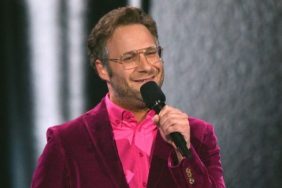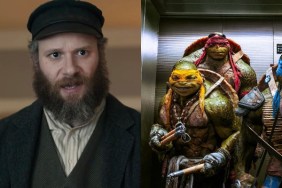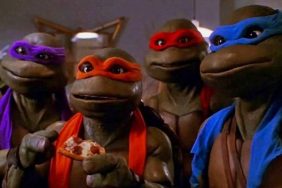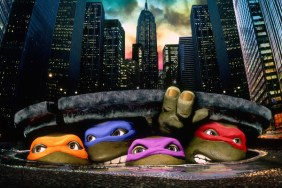When you’re rebooting a movie franchise, it is incumbent upon you to make a few changes. For a new generation? Perhaps. To right old wrongs? Maybe. But whatever the reason, new versions of old films – like this week’s Teenage Mutant Ninja Turtles – have a tendency to make alterations to the characters that old school fans may or may not appreciate. So when CraveOnline got a chance to interview screenwriters Josh Applebaum, Evan Daugherty and André Nemec about their screenplay for Teenage Mutant Ninja Turtles, we wanted to find out why every single change was deemed necessary, whether the change was ultimately brilliant or just plain “different.”
Related: Editorial: How Adults Stole Kids Movies
So SPOILER WARNING, he following interview with the screenwriters of Teenage Mutant Ninja Turtles will discuss the film’s plot points – in particular the Turtles’ new origin story – in detail. If you’ve already seen the film and want to know why it’s so different from the previous versions, this is the interview for you. If you haven’t seen it yet (and you fully intend to), then consider yourself warned.
Related: Nine TMNT Characters We Want in the Films
CraveOnline: Okay gentlemen, you wrote a Teenage Mutant Ninja Turtles movie. Was it handed to you, like they wanted certain things in the movie, or did they want you to start from scratch?
Josh Applebaum: There were open discussions with the studio about what were the most important things in making a Ninja Turtles movie, and then went through different iterations where Casey Jones was going to be at the front of it, but ultimately landing on April and Shredder and those things was not a terribly difficult decision because they’re so…
André Nemec: Well, we went through an exploratory process to be sure. What really is the story that we want to tell?
What didn’t make the cut? Was there something really, really crazy like, “No, the pizza is their father?”
[Laughs.]
André Nemec: The one thing early on, it wasn’t even a big story point, but we had originally included Bebop and Rocksteady and they survived for many, many, many drafts and then eventually we felt like…
Evan Daugherty: They said, “We’ll see you in the sequel.”
Tell me about the construction of it, because although fundamentally it’s very similar – April is a reporter, she finds out about these turtles, gets swept up in The Foot Clan, Bob’s your uncle – you added a lot to that. You added April’s connection to the Turtles from childhood. Tell me about the decision to do that.
Josh Applebaum: I think, you know, at the heart of every iteration of Turtles, is four Ninja Turtles and April becoming the fifth member of that family. That’s always there. I think in terms of inventing that backstory, the thinking was, can we dig a little deeper and literally make a connection between April’s origins and the Turtles’ origin? So the idea that Splinter is inspired to be a father to the Turtles in the same way that April’s father was a father to her, and that April’s bravery in saving the little baby turtles was what inspired the Turtles to be brave and be heroes themselves. So bring them all together in a literal way in that backstory was kind of the thinking behind it.
I’m seeing that kind of thinking a lot in reboots of existing properties lately, in terms of making connections early on in the backstory so that everything seems integrated. In Amazing Spider-Man his parents had to be behind the spiders, which has certain parallels to this movie. Is that just the thinking now in the screenwriting community, or is that coming from on high? Where do you think this trend is coming from?
Josh Applebaum: It’s a good question.
André Nemec: There’s a special button in Final Draft…
[Laughs.]
Evan Daugherty: “Connect all backstories!”
Josh Applebaum: “Integrate.”
“Dovetail.”
Josh Applebaum: I don’t know. For me it’s about telling the cleanest, simplest, most integrated story as possible, where character, theme and story are all kind of part of the same…
Evan Daugherty: And I think also for these franchises that have been around in other iterations, why reboot it now? And one of the answers is, oh, maybe we have another way of telling this, or another way of looking at this, which is you thought these were disparate elements but let’s propose it in a way in which they’re not. They’re all connected.
I just want to play devil’s advocate here, I’m not saying it’s a bad approach, but you’re saying it’s more interconnected and more natural that way, but isn’t it arguably also dependent on more coincidence, since every character we previously knew is now suddenly interconnected?
Josh Applebaum: Well, I mean speaking for me, I think a lot about minimizing coincidence, so the idea is to get it down to sort of one coincidence.
Evan Daugherty: Yeah, one big coincidence.
Josh Applebaum: So April and the Turtles were in the lab together, and I think if you really go through the movie with a fine-toothed comb that once that domino is set in motion it kind of…
Evan Daugherty: It’s a big one, but it’s really the only one.
André Nemec: I think in fairness, the story it presents allows for a deeper emotional connection in the movie, and I think the value of that [outweighs] the value of an early coincidence.
Let me ask you this, one little detail I noticed. We find out there was a fire at the lab, April saves the Turtles, I don’t want to spoil everything, but it seems like it was late at night. Was April, like, staying over? Did she have a room there?
Josh Applebaum: That’s hardcore detail. I can tell you exactly why. It involves stuff that was cut. April’s father was wise to the bad stuff that was going on and was trying to hotfoot it out of town with April in tow, the idea being I think there was a scene where they pull up out front. They just came from home or they just came from school. He runs up to do something. So there was at one point…
André Nemec: And there was a reference at one point at the end to Sachs taking out her father.
Yeah, that’s very overt by the end. I think that’s pretty clear. What a dick.
[Laughs.]
Here’s something where I wasn’t sure where the connection came from. We learn that Sachs was Shredder’s student, protégé, whatever you want to call it. Was there more depth in how that came about? Because it seems like the connection is a little tenuous in the finished film.
Evan Daugherty: There was stuff that ended up on the cutting room floor, for sure.
Obviously you want them to be connected, so you have this big backstory…?
Josh Applebaum: I think there was more stuff. There, I believe, remains in the movie the idea that Sachs mentions that he was sort of this army brat…
That’s in there.
Josh Applebaum: He’d grown up I think in Okinawa. That is the only reference to it.
Evan Daugherty: We talk about how, being the army brat, he sort of began training at this dojo and met this guy…
André Nemec: The outsider, taken in.
Was there ever a plan to have him fight more then, if he’d been doing all that training? Because the only time we see him fight is with a gun.
Evan Daugherty: You got Shredder though…
You got Shredder.
Evan Daugherty: You really want to see Eric Sachs…?
I just want to see William Fichtner kick a guy in the head, that’s what I want.
Evan Daugherty: He does a little fighting in the lab at the end. Doesn’t he do a little…?
André Nemec: He does a little bit of a shootout.
But I want to see him doing a roundhouse. That’s just me being a William Fichtner fan.
Josh Applebaum: Well, he’s great. That opening of The Dark Knight, the bank man?
I was a fan of his on “As the World Turns.” I go way back.
André Nemec: Oh… [Laughs.]
What was the trick? What was the lynchpin? What was the thing in the movie it took you longest to figure out, and then all of a sudden it clicked?
[Thinking.]
Or was there one? You guys are that good?
Josh Applebaum: No, there were so many things.
André Nemec: It all started as equally long, and not at the same time.
Josh Applebaum: I think, again, there was a lot of discussion at first… and I don’t even know why this started, it was just our bad idea, of beginning with Casey Jones instead of April.
Was it because it because little boys might respond to him more?
Josh Applebaum: I think so, yeah. That was probably what it was, thinking about Transformers. And then ultimately we said, “April?” And it wasn’t just about little kids, it was about knowing that the other movies had done April, maybe this was a different way of approaching it. But you know what? It’s…
André Nemec: In the “real” origin, the origin was with Casey Jones, and April was a character that came in the second iteration it when it slipped into the cartoon.
When you look at the original movie, the live-action one obviously, they really played it up like an urban legend for a while. There’s a story. What’s going on? The Foot Clan itself was an urban legend. Here it moves so briskly it kind of has to be more matter of fact. Was there ever that interpretation?
Evan Daugherty: I believe there does remain this idea of April O’Neil starting to unravel this mystery about what she sees…
André Nemec: The symbol…
But it’s just her, as opposed to the whole city.
Evan Daugherty: Oh, the whole city? Actually that was big a conversation that we had back and forth, maybe you guys did too, about how much the city knows and how much the city doesn’t know, and for some reason that did end up being a big sticking point and a thing that went back and forth. I think it made her seem a little crazier if less people knew about it, which makes you root for her more when she turns out to be correct, as opposed to her just buying into an urban legend that thousands of other New Yorkers believe. That was my thought.
Josh Applebaum: Yeah, and also in the spirit of starting this from the ground up, now after this movie, now the legend of the Turtles will be out there. The legend of these vigilantes will be out there. We kind of wanted to see that happen as opposed to something that already existed before we showed up.
The backstory you’ve got very much integrates the idea that they are mutants, turtles and teenagers, but then the ninja thing feels like it had to come in from a different angle. Tell me about how you solved that problem when you created the origin story.
André Nemec: It came out of the notion that Splinter felt this need, because they were different, his kids were going to need to learn some way to protect themselves and stand up for themselves. So ultimately that comes out of that. Just the idea that they came out of something different.
But I’m thinking more specific than that. He finds a book of Ninjitsu in this one, whereas in previous iterations, for example, he either was a ninja master who got turned into a rat, or he was a rat who was owned by a ninja master and he picked it all up vicariously. Why did you go the book route? Did you just want kids to read more?
[Laughs.]
André Nemec: No, I think that in changing the origin story we just weren’t telling the story of a rat who had, while sitting in his cage, modeled on a kung fu master through the cage window, and we weren’t telling a story about a guy who was kung fu master who became a [rat]. So ultimately we needed to find, again, that avenue for Splinter to have learned himself and then passed that on.
Josh Applebaum: But there’s something kind of…
André Nemec: It was a nice parallel also with the Sachs and Shredder story on the other side, seeing outcasts that were both falling under the tutelage of a father. One to the dark side and one who moved to the lighter side.
Now let Josh talk.
Josh Applebaum: No, no, no! No, no, no!
No? That’s it?
Josh Applebaum: I think he covered it.
André Nemec: Fill it in! Color it in!
You get the last thing. Take us out.
Josh Applebaum: I think you said it already! No, but I think there’s something nice about the idea of, while cleaning up the trash in your home, of the sewer that’s your home, that you come upon this magical book that could change everybody’s lives.
So they could have just as easily have learned fencing if somebody had thrown away a different book.
Josh Applebaum: Exactly!
André Nemec: I want to see the fencing version of this movie!
William Bibbiani is the editor of CraveOnline’s Film Channel and the host of The B-Movies Podcast and The Blue Movies Podcast. Follow him on Twitter at @WilliamBibbiani.







